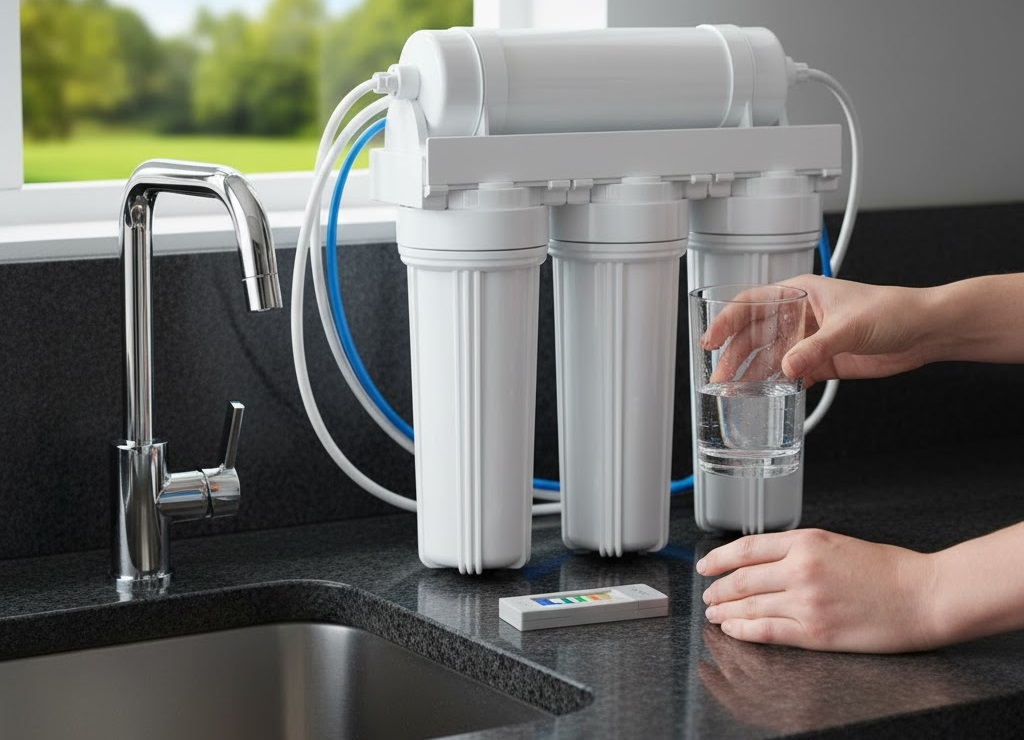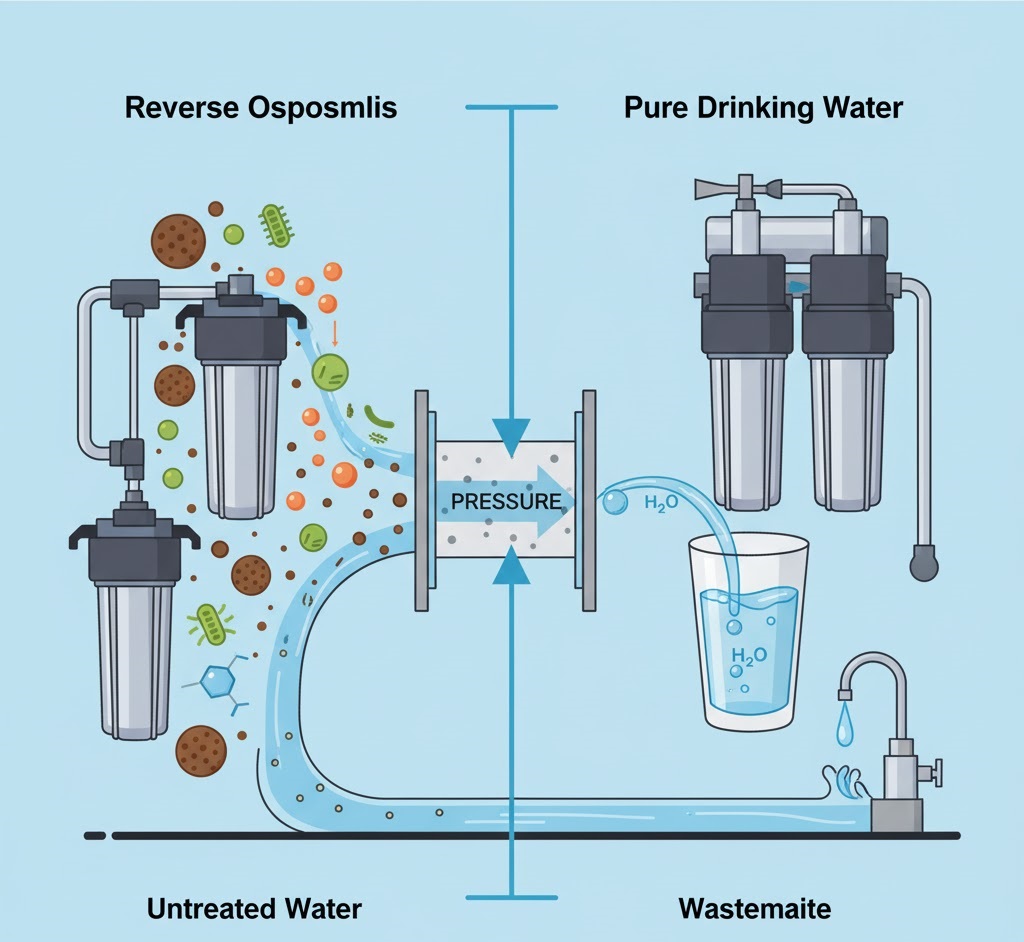Understanding Reverse Osmosis Systems for Drinking Water

Clean, safe drinking water is something every family deserves, but not all tap water meets that standard. Even municipally treated water can contain minerals, chlorine, sediment, and trace contaminants that affect taste and health. For many homeowners, reverse osmosis (RO) systems offer a reliable way to achieve purified, great-tasting water directly from the tap.
Reverse osmosis is one of the most effective water purification methods available today. It removes up to 99 percent of contaminants and provides clean, fresh water for drinking, cooking, and even ice-making. In this guide, we’ll break down how RO systems work, their benefits, maintenance needs, and how to decide if one is right for your home or business.

What is a reverse osmosis system?
A reverse osmosis system is a water purification technology that uses a semipermeable membrane to remove dissolved solids, minerals, and contaminants from water. It’s the same process used in bottled water production and large-scale desalination plants, but scaled down for residential and commercial use.
The term “reverse osmosis” refers to reversing the natural process of osmosis. In osmosis, water naturally moves from areas of low solute concentration to areas of high solute concentration. In RO, external pressure forces water through a special membrane that blocks contaminants and allows only pure water molecules to pass through.
How reverse osmosis works: step-by-step
A standard reverse osmosis system typically includes four to five filtration stages, each performing a unique function:
1. Sediment pre-filter
Removes large particles such as sand, rust, and dirt to protect the system’s delicate components from clogging.
2. Carbon pre-filter
Reduces chlorine, chloramines, and organic chemicals that can damage the RO membrane and cause bad taste or odor.
3. Reverse osmosis membrane
This is the heart of the system. The semipermeable membrane filters out microscopic contaminants, including heavy metals, fluoride, nitrates, and dissolved salts.
4. Post carbon filter (polishing stage)
After water passes through the membrane, a final carbon filter removes any remaining taste or odor, ensuring clean, crisp water.
5. Optional UV or remineralization stage
- UV disinfection kills bacteria and viruses.
- Remineralization adds small amounts of calcium and magnesium for improved taste and pH balance.
Once purified, the water flows into a storage tank and is dispensed through a dedicated faucet at your sink.
What contaminants does reverse osmosis remove?
Reverse osmosis systems can remove a wide range of impurities that other filtration methods cannot.
Common contaminants removed by RO include:
- Lead and other heavy metals
- Chlorine and chloramines
- Fluoride
- Arsenic and nitrates
- Pesticides and herbicides
- Dissolved salts and minerals
- Microorganisms (with UV or multi-stage setups)
- PFAS (“forever chemicals”)
- Volatile organic compounds (VOCs)
RO filtration is so effective that it’s often used in laboratories, aquariums, and medical facilities that require ultra-pure water.
Benefits of a reverse osmosis system
1. Healthier, safer drinking water
Reverse osmosis removes contaminants linked to various health risks, such as lead, arsenic, and nitrates. It’s an excellent solution for families who want to minimize chemical exposure or who live in areas with aging infrastructure or well water concerns.
2. Great taste and odor
By removing chlorine and dissolved minerals, RO water tastes cleaner and fresher. Coffee, tea, and soups made with purified water also taste noticeably better.
3. Cost-effective alternative to bottled water
An RO system can produce a gallon of purified water for just pennies, eliminating the need for single-use plastic bottles. Over time, this can save hundreds of dollars per year.
4. Environmentally friendly
By reducing bottled water consumption, households significantly cut down on plastic waste and carbon emissions from transportation and manufacturing.
5. Versatile use
RO water can be used for drinking, cooking, humidifiers, steam irons, and even aquariums. It’s especially useful in areas with hard water or poor taste.
Common misconceptions about reverse osmosis
Myth 1: RO systems waste a lot of water
Older models did waste more water during the purification process, but modern systems are far more efficient. Many now recover up to 80 percent of input water, and some include permeate pumps to further reduce waste.
Myth 2: RO water is “too pure” or unhealthy
Some people worry that RO water removes beneficial minerals. While it does strip out trace minerals, those make up a very small part of our daily intake, which primarily comes from food. Many modern systems include a remineralization stage to restore a balanced taste and pH.
Myth 3: RO systems are difficult to maintain
Routine maintenance is simple. Most filters only need to be replaced once or twice a year, and the membrane can last up to five years.
Is reverse osmosis right for your home?
Reverse osmosis systems are ideal for households with:
- Poor-tasting or discolored tap water
- High levels of dissolved solids or minerals
- Concerns about lead, fluoride, or nitrates
- Private well systems that test positive for contaminants
- Preference for bottled-water quality directly from the tap
However, for homes with very hard water, pairing the RO system with a water softener or whole house filtration system ensures optimal performance and longer membrane life.
Types of reverse osmosis systems
Under-sink (point-of-use) systems
The most common type, installed beneath your kitchen sink with a dedicated faucet for drinking water. Compact and efficient for daily household use.
Countertop systems
Portable units ideal for renters or small spaces. These connect directly to a faucet and require no permanent installation.
Whole-house reverse osmosis systems
Larger systems that treat all incoming water. These are common in homes with private wells or severe contamination issues.
Commercial and industrial RO systems
Designed for restaurants, hospitals, and manufacturing facilities that need large volumes of purified water.
Installation and maintenance
Professional installation
While DIY kits exist, professional installation ensures proper sizing, pressure calibration, and leak-free operation. Experts can also integrate pre-filters or softeners if your water contains high mineral content.
Routine maintenance checklist
- Replace sediment and carbon filters every 6–12 months.
- Replace the RO membrane every 2–5 years, depending on usage and water quality.
- Sanitize the storage tank annually.
- Inspect fittings and tubing for leaks or wear.
Keeping up with maintenance ensures consistently pure water and extends system life.
If you live in East Tennessee or the surrounding region, professional testing and RO installation services are available through Advanced Heat, AC, & Plumbing or their dedicated Water Analysis page. Their experts can help test your water and recommend the right system for your needs.
Comparing reverse osmosis to other filtration systems
RO systems offer the most comprehensive purification, especially when combined with pre-filtration or UV sterilization.
Potential drawbacks of reverse osmosis systems
1. Reduced water pressure
Because water passes through multiple filters, flow rate may be slightly lower. However, modern systems use pressurized tanks or pumps to maintain consistent output.
2. Water waste
Some water is used to flush away contaminants, though modern systems minimize this to just a few gallons per day.
3. Initial cost
While installation costs can range from $300 to $800 for residential systems, the long-term savings over bottled water make it a worthwhile investment.
4. Space requirements
Under-sink systems include a storage tank and filters, so you’ll need some cabinet space for installation.
Despite these factors, most homeowners find the benefits far outweigh the drawbacks.
Enhancing your RO system with add-ons
- Remineralization filters: Add calcium and magnesium back into the water for a balanced, natural taste.
- UV sterilizers: Provide additional protection from bacteria or viruses.
- Permeate pumps: Improve system efficiency and reduce wastewater.
- Inline TDS meters: Allow you to monitor filter performance and water quality.
These enhancements are easy to integrate and can tailor your RO system to your specific needs.
Environmental impact and sustainability
Reverse osmosis systems can play a significant role in reducing environmental waste. By replacing bottled water with RO-purified water, households prevent hundreds of plastic bottles from entering landfills each year. Additionally, modern systems use less water and electricity than ever before, aligning with sustainability goals.
For eco-conscious homeowners, choosing an RO system with high efficiency and reusable filters helps further reduce the environmental footprint.
FAQs: Reverse Osmosis Systems
How much does a reverse osmosis system cost?
Residential systems typically cost between $200 and $800, depending on brand, size, and installation.
Does reverse osmosis remove fluoride?
Yes. RO membranes effectively remove fluoride along with other dissolved minerals.
How often should I change my RO filters?
Pre-filters should be replaced every 6–12 months, while the membrane typically lasts 2–5 years.
Is reverse osmosis water safe for pets and plants?
Yes. RO water is perfectly safe for both, though plants may benefit from occasional mineral supplementation.
Can I connect an RO system to my refrigerator or ice maker?
Yes. Most under-sink RO systems can be connected with a T-fitting for filtered water and ice.
Does RO water taste different?
Yes. Many people describe it as smoother, cleaner, and free of chlorine or metallic aftertaste.
What if I have hard water?
Install a water softener before the RO system to protect the membrane and improve efficiency.
Does reverse osmosis remove beneficial minerals?
It removes trace minerals, but these are minimal compared to your diet. If desired, use a remineralization stage to restore balance.
Is RO water better than bottled water?
In most cases, yes. It’s cleaner, more affordable, and better for the environment.
Can I install it myself?
Some systems are DIY-friendly, but professional installation ensures optimal performance and leak prevention.
Conclusion
A reverse osmosis system is one of the most effective ways to ensure clean, great-tasting drinking water for your home or business. By removing contaminants, improving taste, and reducing reliance on bottled water, RO technology provides long-term health and environmental benefits.
Key takeaways:
- Reverse osmosis removes up to 99 percent of common contaminants.
- Systems can be customized with UV, carbon, and remineralization stages.
- Maintenance is minimal and cost savings are significant over time.
- Ideal for both municipal and well water sources.
If you’re ready to enjoy purified water straight from the tap, schedule a professional water analysis today with Advanced Heat, AC, & Plumbing. Their Water Analysis experts can test your water quality, explain your results, and recommend the best reverse osmosis system for your needs. Cleaner, healthier drinking water is just one installation away.





